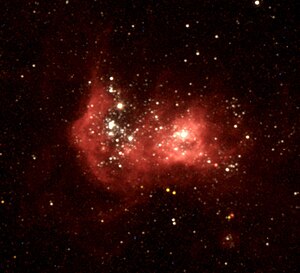NGC 2363
| Galaxy NGC 2363 |
|
|---|---|

|
|
| NGC 2363 and NGC 2366 imaged by the Hubble Space Telescope | |
| AladinLite | |
| Constellation | giraffe |
|
Position equinox : J2000.0 , epoch : J2000.0 |
|
| Right ascension | 07 h 28 m 29.6 s |
| declination | + 69 ° 11 ′ 34 ″ |
| Appearance | |
| Morphological type | in the |
| Brightness (visual) | 14.9 mag |
| Brightness (B-band) | 15.5 mag |
| Angular expansion | 1.6 ′ × 1 ′ |
| Position angle | 20 ° |
| Surface brightness | 15.3 mag / arcmin² |
| Physical data | |
| Affiliation | M81 group |
| Redshift | (+233 ± 3) · 10 −6 |
| Radial velocity | 70 km / s |
|
Stroke distance v rad / H 0 |
(8 ± 1) x 10 6 ly (2.46 ± 0.18) Mpc |
| history | |
| discovery | Ralph Copeland |
| Discovery date | March 9, 1874 |
| Catalog names | |
| NGC 2363, 2366A • UGC 3847 • PGC 21078/93088 • MCG + 12-07-039 • GC 5377 • | |
NGC 2363 is an irregular galaxy of Hubble type in the constellation Giraffe at the northern sky . It is about 8 million light years from the Milky Way and a member of the M-81 group . During the first observations of the object, it was classified as a star formation region of the galaxy NGC 2366 .
The object was discovered on March 9, 1874 by Ralph Copeland .
Web links
Commons : NGC 2363 - collection of images, videos, and audio files
- Hubble Space Telescope
- Bright Stars, Dim Galaxy - Astronomy Picture of the Day from October 14, 1996 (English).
